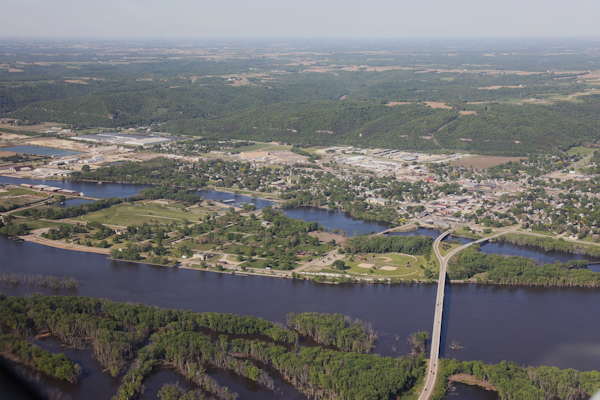SEJournal Online is the digital news magazine of the Society of Environmental Journalists. Learn more about SEJournal Online, including submission, subscription and advertising information.
 |
 |
| The Mississippi River, photographed from an airplane near Guttenberg, Iowa, on May 25, 2023. Photo: Drake White-Bergey, Wisconsin Watch; aerial support provided by LightHawk (courtesy Mississippi River Basin Ag & Water Desk). |
Feature: Reporting on Environmental Solutions and Equity — at a Watershed Scale
By Annie Ropeik
Boundaries and borders created and enforced by humans are all around us. But the rivers, lakes, aquifers and oceans that connect and shape our landscapes know no such delineation.
Finding the interconnected ecosystems in a given coverage area, and reporting on ways to restore, preserve and sustain them beyond state lines or water district limits, can lead to better stories — and better public understanding of our precarious relationship with our landscape in the era of the climate crisis.
Reporting collaboratives like the Mississippi River Basin Ag & Water Desk and The Water Desk at the University of Colorado Boulder are working to bring new kinds of watershed-scale coverage to audiences across the country.
Connecting the dots
When it comes to covering large rivers, journalists have untapped opportunities to trace how water moves across the landscape, communities, industries and regulatory schemes — and to help the public connect the dots between these areas, finding policy gaps and openings for new collaboration.
Bryan Hopkins, The Nature Conservancy’s freshwater conservation director on the Upper Mississippi River, suggests there are many ways regulators could use a systems-based approach to better prevent pollution and river degradation.
‘The water that falls on a farmer's field
is eventually going to end up
in your glass of water.’
— Bryan Hopkins,
The Nature Conservancy
He added, “Simply understanding that the water that falls on a farmer's field is eventually going to end up in your glass of water, and it's eventually going to end up in a coastal zone — how that water behaves through the whole system is critical for every one of those facets.”
The Mississippi River, for example, has no multistate regulatory scheme, despite draining about 40% of the country, touching 31 states and many tribes and even nudging into Canada.
This could change — mayors with the Mississippi River Cities and Towns Initiative recently backed the idea of a 10-state compact for the basin, which could allow collective approaches to conservation and resilience.
“There is a growing understanding … that there needs to be a big-picture thinking, that this compartmentalization of regional concerns and zones (has) been useful on a regional basis, but then it fails miserably to look at large issues, which certainly climate change is driving,” said Hopkins.
Getting past old ways of thinking
Even rivers that do have broader management methods face deepening challenges. Take the Colorado, which despite its decades-old allocation plan is in a well-documented crisis of drought and overuse.
“This is a very intense moment, and for right or wrong, it really has caught a lot of people somewhat flat-footed,” said Daniel Cordalis, an attorney and the tribal partnerships manager for the Colorado River Sustainability Campaign. “There’s huge ideas being discussed … and the situation is really kind of overwhelming in a lot of ways. And so that's pushing the government system significantly.”
So how can journalists help audiences feel less overwhelmed?
Peter Culp, also a Western water attorney, said regulators, residents and reporters alike must move away from thinking of watershed management as a “zero-sum game.”
“Conflict is basically inevitable if our goal is to use as much water as possible, which has historically been the goal. Along with the settlement of the Western United States, it's like a system that encourages the most rapid possible exploitation of resources,” Culp said. “In this new situation, the goal is not necessarily to use as much as possible. The goal is probably resilience.”
Shedding light on evolving approaches
With big challenges ahead, some of the people working with watershed communities say reimagining community engagement is essential.
Janae Davis, the Southeast conservation director of American Rivers, has seen mixed results in the Catawba-Wateree Basin in the Carolinas. The region’s watershed management council involves large and small utilities and local communities, and while the watershed is “one of the hardest-working” in the Eastern United States in terms of users, Davis said this collective decision-making has helped make it “relatively healthy.”
Elsewhere, Davis said advocates are working on flood management plans that take community knowledge and culture into account, as well as hydrology and climate change — hoping to create approaches to resiliency that preserve heritage, improve public health and fight generational inequality.
“I really honestly think that community-based approaches are, at least in our region, the best approaches so far,” she said. “The crux of the work that we do is not only inviting folks to the decision-makers’ circle but to also make sure that those committees are actually heard. … Otherwise, it's just a checkbox.”
Across the country, advocates are
still finding barriers to bringing
historically underrepresented
communities into the fold.
But in the Carolinas and across the country, advocates like Davis are still finding barriers to bringing historically underrepresented communities — especially Black and Indigenous people and other people of color — into the fold of planning and benefitting from these new approaches.
“A lot of folks in the [Catawba] watershed, who are the most vulnerable and most impacted [by environmental issues], … they are invited to the table, but the table does not accommodate them,” Davis said. “For instance, they have citizen engagement groups that meet in the middle of the day on Thursday. Like, how can your average working-class person make it to that session?”
Experts said journalists can play a greater role in shedding light on these issues, and examining new and evolving tools for more inclusive management and community outreach.
What’s next?
For reporters, the rollout of Inflation Reduction Act funds and other major climate and environmental justice investments will be a crucial new vehicle for exploring who benefits and who is excluded.
“[The IRA] is an incredible influx of money going to these communities. I would venture to say that they will be able to be more engaged in a lot of this watershed work,” said Mary Lou Soscia, the retired former Columbia River coordinator for the U.S. Environmental Protection Agency. “They will have more to say. They'll be able to fund people to be participating in science and participating in decision-making. And I think that's a great story for [journalists] to tell.”
What else do the experts think reporters should be thinking about as they dig into the future of rivers like the Mississippi, Colorado and Columbia and their watersheds?
“We're seeing increased convergence of quality and quantity issues, and they cannot be solved to the detriment of the other,” said Justin Hayes, the executive director of the Idaho Conservation League. “This is really a time to recognize that the systems that we have either created or relied on are changing.”
The Nature Conservancy’s Hopkins agrees. Historical assumptions of excess in major watersheds combined with rapid development and attempts at control of nature are beginning to “come back and bite us,” he said.
Meanwhile, climate change is worsening floods and other extremes in urban areas, for farmers and more, as other environmental stressors pile up.
“We're at a point in time where we're going to have to, absolutely, as a society, change our relationship with water,” Hopkins said. “It's going to be complicated, but it absolutely is here. It’s on the doorstep.”
[Editor’s Note: For more on covering watersheds as connected systems, check out a workshop (including audio recordings) on the subject from the Society of Environmental Journalists’ 2023 annual conference. Author Ropeik emceed the workshop and drew material for this article from it. Plus, see a previous SEJournal Feature discussing watershed coverage. Also note that news outlets can run the Mississippi River Basin Ag & Water Desk’s stories for free – editors may sign up here. The Desk is an independent reporting network based at the University of Missouri in partnership with Report for America and SEJ, funded by the Walton Family Foundation. Subscribe to the Desk’s biweekly newsletter to get the latest headlines from the basin. And stay tuned for details on next year’s journalist workshop on watershed-scale coverage at the 2024 SEJ conference in Philadelphia.]
Annie Ropeik is an independent climate journalist based in Maine and a board member with SEJ, serving as secretary. She is the assistant director of the Mississippi River Basin Ag & Water Desk. Her reporting regularly appears in outlets such as The Maine Monitor and Energy News Network, and she was a 2023 journalism fellow with the MIT Environmental Solutions Initiative. Ropeik spent about a decade as a local public radio reporter and host in New Hampshire, Indiana, Delaware and Alaska. Her work has appeared on NPR programs, the CBC, BBC and podcasts such as “Outside/In,” and has earned honors from SEJ, the Public Media Journalists Association and the U.S. EPA (Region 1).
* From the weekly news magazine SEJournal Online, Vol. 8, No. 40. Content from each new issue of SEJournal Online is available to the public via the SEJournal Online main page. Subscribe to the e-newsletter here. And see past issues of the SEJournal archived here.













 Advertisement
Advertisement 




